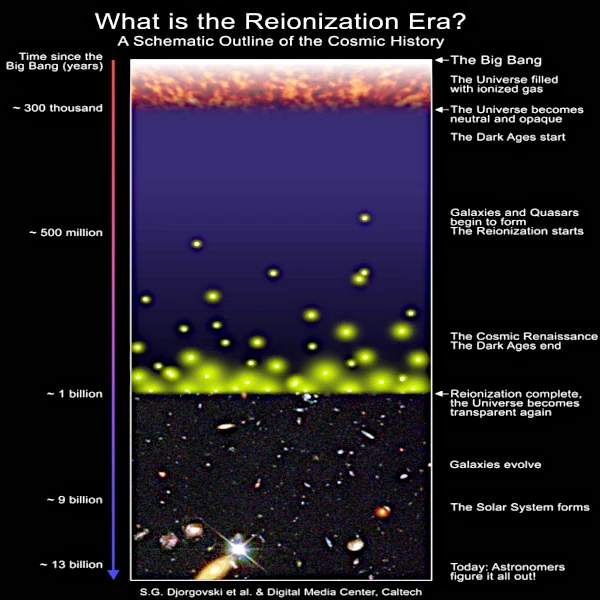
Image: S. G. Djorgovski et al., Caltech..
In cosmology, the dark ages of the universe refer to a relatively unknown period of our cosmos. The term dark ages is the epoch in the history of the Universe located between the emission of the cosmic microwave background and the ignition of the first generation of stars.
During this period, no astrophysical process produces electromagnetic radiation. There is therefore no way using light to probe the state of the Universe at these times.
This phase extends from approximately 370,000 to 150 million years after the Big Bang.
During the early days of the universe, the temperature was extremely high, preventing the formation of stable atoms. Subatomic particles were ionized, meaning electrons were stripped from their atoms.
About 370,000 years after the Big Bang, the temperature dropped enough to allow recombination.
The main players in recombination are protons (hydrogen nuclei) and electrons. Before recombination, the strong thermal energy kept these particles separated. Once the universe cooled enough, electrons were able to combine with protons to form neutral hydrogen atoms.
The recombination released photons, forming the cosmic microwave background, electromagnetic radiation that fills the universe.
It is this radiation that we still detect today in the form of microwaves.
During the Dark Ages, the universe continued to expand, diluting the density of matter. The universe was composed primarily of hydrogen and helium, with fluctuations in density that ultimately led to the formation of the first cosmic structures.
This period is of particular importance because it marks the transition from a homogeneous initial phase to the beginning of the complex structure that we observe in the modern universe.
Under the influence of gravity, the matter present in the universe has become denser and agglomerate. The first stars appear from these densified regions.
The end of the dark ages is marked by reionization. The first stars emit intense ultraviolet radiation as well as other ionizing radiation. These radiations have the ability to "break" the bonds between the electrons and protons of neutral hydrogen atoms, thus ionizing the hydrogen.
It is the beginning of another era, the era of reionization where the diffuse matter of the universe, mainly composed of neutral hydrogen, is ionized again.